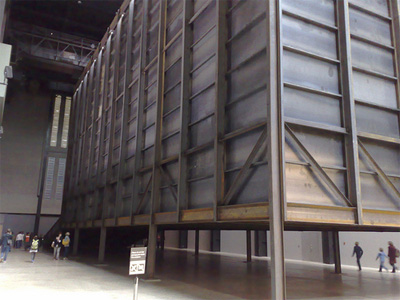
[photo by fairlybouyant @ flickr under creative commons]
at the tate yeserday, where i finally saw miroslaw balka's how it is, his installation in the turbine hall, a vast, dark steel container you enter by walking up a ramp then wander around inside. i was disappointed, to be honest. one of the main intentions (i assume he oversaw the accompanying explanatory text) is to profoundly disorient and unsettle the viewer by plunging them into complete darkness, which it does only very briefly. after a matter of seconds you can see the walls (just) and other people and, at any point, you can turn round and see the great rectangle of light where you entered (i actually found it more impressive from the outside, much as i find the millennium wheel more impressive from underneath).
i've read a number of enthusiastic reviews from critics who seem to agree with jonathan jones in the guardian who described the work as terrifying, awe-inspiring and thought-provoking. it embraces you with a velvet chill. which makes me wonder whether he has ever been in the countryside at night. i periodically stay in a part of Herefordshire where there is almost no ambient light at night. when there is cloud cover it is really, really dark. if you wander round outside it's a lot more terrifying, awe-inspiring and thought-provoking than a huge steel container on the south bank. Sometimes it scares the living crap out of me.
how it is kept reminding me of works by the boyle family and mike nelson, artists who recreate in the gallery, with creepy verisimilitude, environments you might find elsewhere. sure it's a surprise to find a pavement on a wall or a huge room filled sand. the change of context makes you think. a bit. but the displaced environment is always reduced in other respects. it's frozen in time. the light is static. the temperature is static. there's no wind, no smell. it's bounded. you can't roll around in it and climb over it and grab handfuls of it.
the world is rich and deep and fascinating. copying bits of it and putting them in a gallery seems rather pointless to me and on the wholeiI prefer artists who add something to the world.
oddly the other work which came to mind when i was walking around in the not-quite-dark was plight by joseph beuys which is - or at least was a few years ago -permanently installed in the centre pompidou: two rooms connected by a low doorway, containing a piano, a table and a thermometer, the walls lagged with thick rolls of heavy felt. beuys doesn't eliminate all sound - just as balka doesn't eliminate all light - but the way in which sounds are so effectively deadened, the way sounds seems to be sucked out of the air is - unlike balka's container - deeply unsettling.
this is doubtless connected to something i had never never really considered before (beuys’ work was more thought-provoking in memory than balka’s was when I was inside it), that we can easily experience the complete absence of light, but despite our regular references to silence, we never experience the complete absence of sound, for even in the quietest places we hear the breath going in and out and the tiny roar of the blood and that faint, high-pitched whine, hardly a noise at all, which sounds as if some nearby electrical object has been left on standby. which i guess it has.